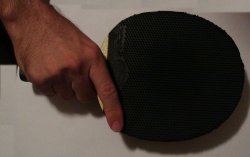
As you can see from the photographs, the index finger is extended along the bottom of the racket, with the thumb being relaxed on the blade, rather than the rubber. The bottom three fingers are used to grip the handle. The basic grip is achieved by ‘shaking hands’ with the racket, hence the name.
Advantages
The advantages of this grip is that it will give you extra power and allow easy adjustment of the racket angle due to the looseness of the grip, and the ability to use the wrist more. This increases the amount of power and spin that can be given to the ball, and also helps it to be effective against short balls that would bounce twice on the table.
It is also easy to perform all forehand and backhand strokes with this grip, making it well suited to players who wish to attack from both sides of their body.

Disadvantages
A disadvantage of this grip is that any player using this grip has what is often called a ‘crossover point‘, or an ‘area of indecision’, where the ball cannot easily be struck with either the forehand or backhand side, and a decision to use one or the other stroke must be made.
What Type of Player Uses This Grip?
This grip tends to be used by topspin style players, as well as drive style players.
If the index finger is not placed on the blade, but instead allowed to curl around the handle with the remaining three fingers, it is called a hammer grip. This grip is not recommended due to its poor racket control.

